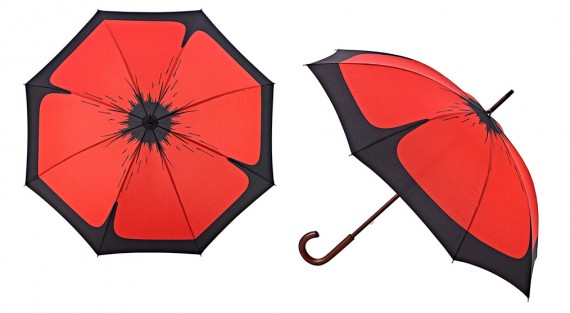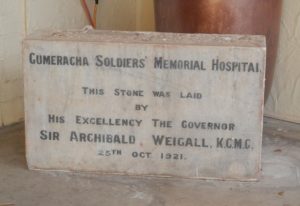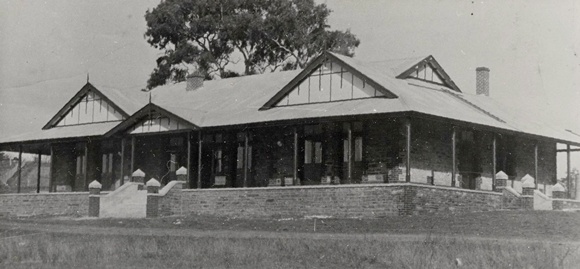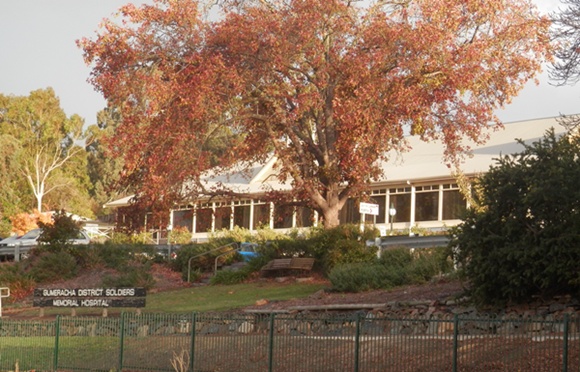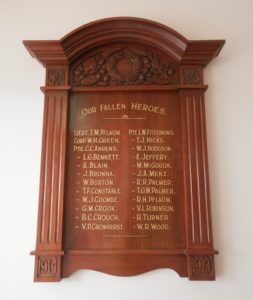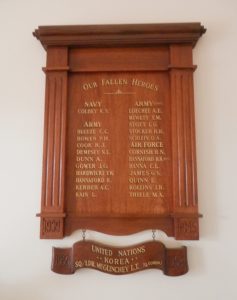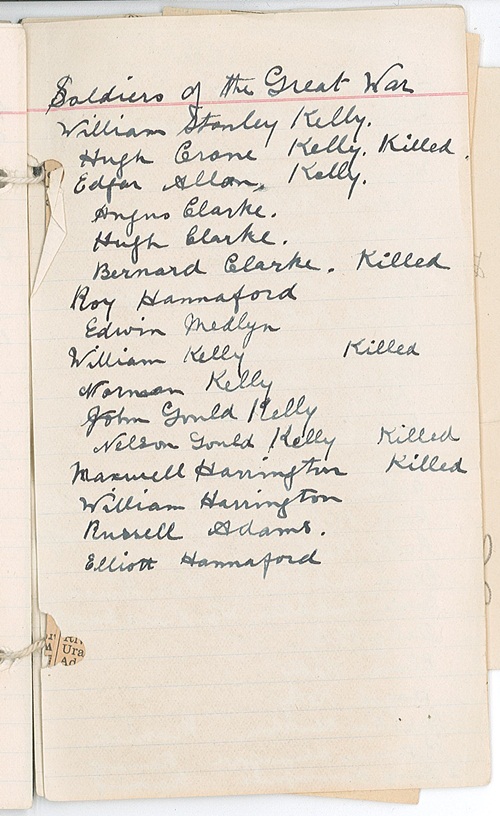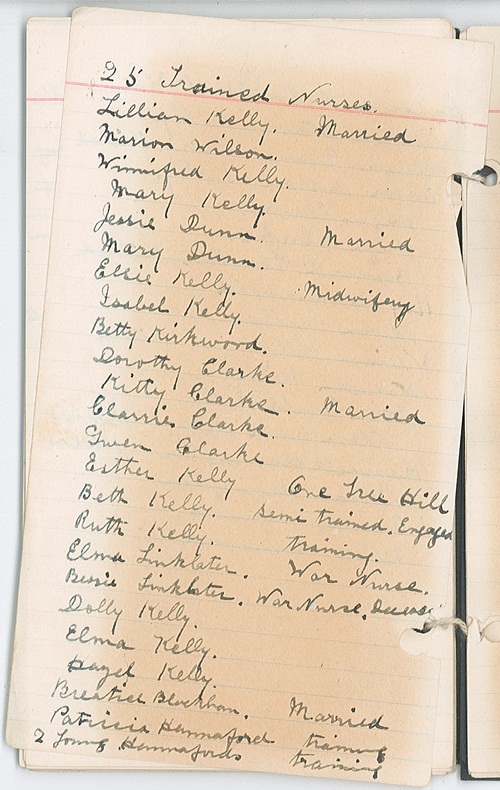The Poppy Umbrella
If you’re in need of a new umbrella, or even if you aren’t, but like to put your money to a good cause … buy a Poppy umbrella.
I first saw these poppy umbrellas at the Families and Friends of the First AIF stand at Congress in Sydney in 2018, and bought one there, and since then I’ve bought a few more and given them as gifts.
The poppy of course is a symbol of remembrance of the First World War, that is strongly linked with Armistice Day (11 November), but the poppy’s origin as a popular symbol of remembrance lies in the battlefields of the First World War, where poppies were a common sight, especially on the Western Front.
These umbrellas not only look fabulous with a giant red poppy graphic, but as mentioned before, the funds go to a good cause …
Here’s a few paragraphs from the FFFAIF website which gives information about the umbrella, and what the funds go to …
The Poppy Umbrella, resembling a Flanders poppy when open, is manufactured for Rembrella by Fultons, the largest supplier of quality umbrellas in the UK. They are only available for sale through registered charities of ex-Service and welfare organisations, or military and heritage museums, or educational associations and not-for-profit organisations, and in 2009 Rembrella appointed Families and Friends of the First AIF (FFAIF) as its Australian importer.
Sales of the umbrellas enables FFFAIF to contribute funding to Commemorations in Sydney for Fromelles Day and the Battles of 3rd Ypres as well towards the costs of headstones on unmarked graves of returned Diggers.
The Poppy umbrellas are available in three different styles: Telescopic (small and compact), Standard (tall with a wooden curved handle) and Golf Umbrella (large).
The FFFAIF don’t have online ordering on their website, but if you contact them and they can send you an order form, or you can simply call and place an order over the phone. Below are the specifications of each style. Prices are in Australian dollars.
 Telescopic Poppy Umbrella
Telescopic Poppy Umbrella
A handy folding umbrella, light and easy tp cally for everyday use.
– 53cm fib length
– 3 stage manual telescopic
– 24cm long when closed
– has a carry strap and clear PVC protective sleeve
$45.00 + p&h ($9 postage for 1-2, $15 postage for 3-4)
Standard Poppy Umbrella
This traditional style wooden ‘crooked’ handle umbrella will add a vivid splash of colour on a wet (or sunny) day.
– 59cm rib length, 90cm shaft length
– wooden shaft and wooden crooked handle
– cover diameter 102cm
– includes a black protective sleeve
$50.00 + p/h (contact FFFAIF for postage cost)
Golf Style Poppy Umbrella
A large, lightweight umprella, ideal for outdoor activities like golfing or walking.
– 77cm rib length, 98cm shaft length
– cover diameter 134cm
– lightweight fibreglass frame
– black ‘pistol grip’ handle
$55.00 + p/h (contact FFFAIF for postage cost)
—————————-
Disclosure: Just to be clear, I have no affiliation with FFFAIF other than being a paying customer who loves their umbrellas. I simply wanted to write about them so others know where they can get their own good quality, great looking, and supports a good cause umbrella.
If you’d like to keep up with the latest news from the Friends and Families of the First AIF, follow their Facebook page. Or if you’re like to get in touch, their contact details are:
Email: enquiries@fffaif.org.au
Phone: (02) 6882 6270
Address: PO Box 4245, Forster, NSW 2428 Australia
Armistice Day in Adelaide: 100 Years Ago
After four long, horrific and heartbreaking years of war, Monday 11 November 1918 was a day that changed history. It’s the day known as the day “the war ended”, although technically it continued for some time afterwards.
It’s the day when the Armistice agreement was signed.
And when news of the signing of the Armistice came, it was celebrated around the world, including in my home city of Adelaide, South Australia. The newspapers reported it, and photographs were taken, so through these we get a small sense of the overwhelming relief and joy.
From the Eyre’s Peninsula Tribune, Friday 22 November 1918, comes the following article:
The Armistice Celebrations.
Tuesday and Thursday will be ever memorable in Australia’s history. On Monday night the signing of the armistice by Germany was announced, and it was not long before the streets were thronged with delighted crowds. Everywhere the people gave themselves over to orderly thanksgiving for the Allied deliverance of civilisation from the hands of the unspeakable Hun. Festivities were indulged in up to a late hour, few being more enthusiastic in heaping maledictions on the enemy than many thousands of men and youths who “went to war” by not going to it. On Tuesday the solemn official celebration drew the biggest concourse the city has ever known. North Terrace was packed, with sightseers anxious to express their joyful feelings at the successful termination of the conflict. Parliament met in the afternoon and surpassed itself with orations that really adorn the pages of “Hansard.”
On Wednesday the celebrations continued to a lesser extent, to be revived on Thursday, when the refusal of the tramway employes to man the cars marred the whole of the proceedings.
It is hoped – nothing of a similar, nature will occur when Peace Day is celebrated — an event that is expected to happen in the near future.
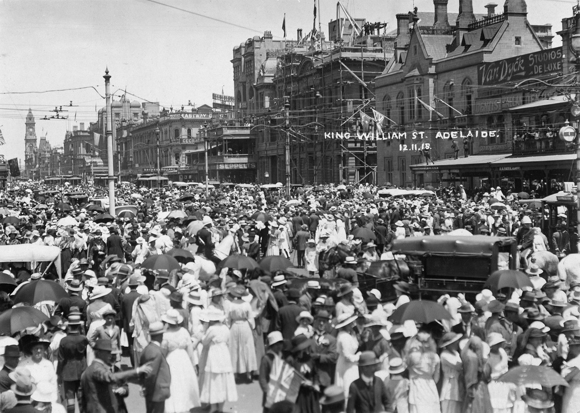
Armistice Day celebrations, King William Street, Adelaide, 12 November 1918
[State Library of South Australia, B 5513] https://collections.slsa.sa.gov.au/resource/B+5513
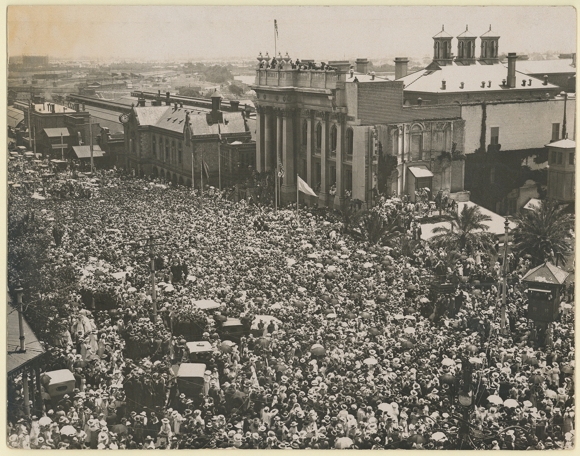
Armistice Day celebrations on North Terrace, Adelaide, 12 November 1918
[State Library of SA, B 8830] https://collections.slsa.sa.gov.au/resource/B+8830
Gumeracha, November 12.
There was great rejoicing when it was known that Germany has signed the armistice. All of the places of business were closed and a general holiday was observed. In the evening a public meeting was held in the town hall. The chairman of the district council (Mr. D. Hanna) presided over a large gathering. Mr E. H. Hannaford moved a loyal resolution, which was carried enthusiastically. Choruses were given by the children of the public school. The Drum and Fife Band played, and songs were given my the Misses Hartlett and Northworthy. Speeches were delivered by Messrs. E. H. Hannaford, Revs. A. Talbot and Hartlett, and the chairman.
So while it’s exciting to see the excitement and jubilation of Armistice Day, we still can’t forget that what started with one bullet on 28 June 1914, ended years over four later with approx 16-20 million people dead, and another approx. 20 million wounded.
To say the world was changed forever would be an understatement. People were changed, families were changed, and entire communities were too.
While current generations for the most part, are not personally familiar with the atrocities of war and all that it brings, it doesn’t mean that we don’t remember and commemorate those who fought and those who died for their country.
Armistice 1918-2018
Lest We Forget
Remembrance Day – Gumeracha’s Fallen Heroes
“On the 11th hour, of the 11th day, of the 11th month
we will remember them”
After more than four years of continuous war, at 11am on 11 November 1918 the guns of the Western Front fell silent. From that moment the “11th hour of the 11th day of the 11th month” has attained a special significance, and has became forever associated with the remembrance of those who had died in World War 1 and subsequent wars as well.
Remembrance Day (sometimes also referred to as Poppy Day) is a day that has been observed throughout the Commonwealth (Australia included) since the end of the First World War, to remember the members of the armed forces who have died in the line of duty.
There wouldn’t be any town in Australia that wasn’t affected by the Great War on one way or another. So many young men, more of often than not eagerly signed up to do their duty. And sadly not all came home.
Gumeracha is a tiny town in the Adelaide Hills region of South Australia. A typical country town, with a population of few hundred (back then), and one where everyone knows everyone. And it was a town that saw its share of tragedy and despair with a number of men who went to fight for their country, and never returned.
Throughout Australia, in the cities and the country towns, the brave men and women were honoured on thousands of memorials and honour boards that were created, so as to “never forget those brave souls”.
Gumeracha certainly did just that. They have honour boards for both WW1 and WW2, and even a small one for the Korean War. But their ultimate memorial is the Gumeracha District Soldiers’ Memorial Hospital.
In the “Gumeracha District Soldiers Memorial Hospital Diamond Jubilee 1922-1982” book it quotes the following …
“Following the cessation of fighting in World War I the local community held a public meeting in the Gumeracha Town Hall to discuss the formation of a war memorial to commemorate the men who had given their lives in conflict … The meeting unanimously agreed that a memorial pavillion would be built and a Committee was formed to plan fund raising efforts for the building. Dr Rex Matters was through Gumeracha about this time as he spoke with both Mr W.J. Hannaford and Mr J.H. Hynes concerning the advantages to be gained if a larger hospital was built in Gumeracha. The two gentlemen agreed that this would have far greater benefits for the community than the planned pavillion. The site selected would bring the building into prominence and give the ailing persons recuperating at the hospital one of the most glorious views of the surrounding area. The hospital was to be built on top of the hill overlooking the town. Mr J.B. Randell, a local grazier and orchardist, was approached and asked if he would sell the piece of land on the top of the hill so that a hospital may be built thereon. To this he agreed, and £100 was paid for the site.”
The hospital was officially opened on 22 July 1922, and is still running to this day. When you enter the hospital one of the first things you see is the WWI Honour Roll, and alongside that is one for the fallen heroes from World War II and the Korean War.
Our Fallen Heroes – WW1
Lieut. T.M. Pflaum
Corp. W.H. Green
Pte. C.C. Ahrens
Pte. L.G. Bennett
Pte. R. Blain
Pte. J. Bronha
Pte. W. Burton
Pte. T.F. Constable
Pte. W.J. Coombe
Pte. G.M. Crook
Pte. B.C. Crouch
Pte. V.P. Crowhurst
Pte. L.W. Fitzsimons
Pte. T.J. Hicks
Pte. W.J. Hodgson
Pte. E. Jeffery
Pte. M. McGough
Pte. J.A. Menz
Pte. R.R. Palmer
Pte. T.G.W. Palmer
Pte. R.H. Pflaum
Pte. V.L. Robinson
Pte. R. Turner
Pte. W.R. Wood
Our Fallen Heroes – WW2
Navy
Colbey, R.S.
Army
Bleeze, C.C.
Bowen, P.H.
Cook, R.J.
Dempsey, N.L.
Dunn, A.
Gower, J.G.
Hardwicke, F.W.
Hannaford, R.
Kerber, A.C.
Kain, L.
Loechel, A.E.
Mewett, T.M.
Stott, L.G.
Stocker, H.R.
Schlein, D.A.
Air Force
Cornish, H.N.
Hannaford, H.R.
Hanna, C.L.
James, G.S.
Quinn, E.
Rollins, J.R.
Thiele, M.A.
Our Fallen Heroes – Korea
Sq/Ldr McGlinchey, L.T.
So while we take a moment in our busy lives to remember those who served, and the sacrifice they made for us and our country, we also think of those in the small town communities who made sacrifices to be able to honour their friends and family who never returned.
Gumeracha is a community town. The hospital was paid by the generosity of those in the community combined with the extraordinary efforts of the fund raising committee. So the Gum hospital was largely built by those in community, for the community – and stands as an incredible memorial to those who never returned.
“Lest We Forget”
On the 11th hour, of the 11th day, of the 11th month …
For Remembrance Day this year I wanted to share with you a couple of pages from what is known as the “Kelly Diary”. And I am eternally grateful to not only have a copy of this diary, but also that the current keeper of this treasure has kindly allowed me to reproduce these pages here.
But first of, let me start by saying, no, these are not descendants from the Ned Kelly line in Ireland, but rather those from the Isle of Man. Or should I say the line of William Kelly born near Ramsey, Isle of Man in 1804 to be a tad more specific – since the Kelly name is like Smith in the region.
The ‘diary’, and I write it in quotes because it is not strictly a diary, was written by Elise Marcia Kelly of Joslin in South Australia in late 1938. In this 34 page booklet she not only writes the lineage history from William Kelly (born 1804), together with information on the big 100 year reunion that was held in 1938, but also details of those who were involved in World War 1. And it is these pages I am sharing with you today.

